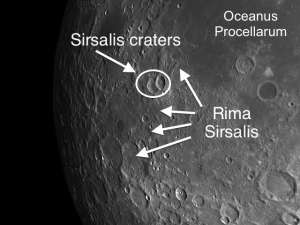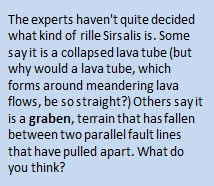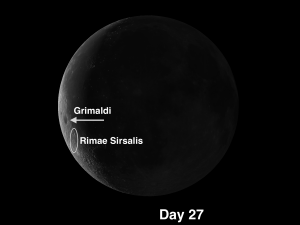The week of Aug. 29th – Sept. 4th takes us from the beginning of Day 27 to Day 3. For the intrepid viewers among you, the Moon rises at 3:40 AM local time on Monday (depending on how far you are from your time zone’s center line, this can vary by ±30 minutes).
 Rimae Sirsalis: [SW/L3-4] On Monday just in from the southwest shore of Oceanus Procellarum you will see two small overlapping craters, Sirsalis and Sirsalis A. Take a look at them and decide which crater is older. (It should be obvious.) Neighboring these two craters to the east and south is a complex of rilles. Rima Sirsalis is the most conspicuous, but it has lots of neighboring offshoots. How many can you see?
Rimae Sirsalis: [SW/L3-4] On Monday just in from the southwest shore of Oceanus Procellarum you will see two small overlapping craters, Sirsalis and Sirsalis A. Take a look at them and decide which crater is older. (It should be obvious.) Neighboring these two craters to the east and south is a complex of rilles. Rima Sirsalis is the most conspicuous, but it has lots of neighboring offshoots. How many can you see?
With your telescope at its highest usable power, trace Rima Sirsalis through its full length. Along the way, try to discern the many smaller rilles that branch off. These require larger apertures and good seeing, but it’s worth the effort.
 Rima Sirsalis is a gift to amateur astronomers because it can be easily seen in the smallest of telescopes. At 240 miles long and two miles wide, it is one of the longest rilles on the Moon, and it also reveals itself just before full Moon–a time when most astronomers are putting their telescopes away!
Rima Sirsalis is a gift to amateur astronomers because it can be easily seen in the smallest of telescopes. At 240 miles long and two miles wide, it is one of the longest rilles on the Moon, and it also reveals itself just before full Moon–a time when most astronomers are putting their telescopes away!
Rima Sirsalis is unusual not only because of its great length, but because it cuts straight through a highland region and is rarely persuaded to deviate from its course. On its southern end, the rille begins just east of the crater Darwin, then proceeds north where it “empties” into Oceanus Procellarum. Spend a lot of time here. Draw the network of rilles and keep coming back to improve on what you think you saw.
OF ADDITIONAL INTEREST ON LUNAR DAYS 27 – 3:
Late summer is a prime time to view the Milky Way, and it’s particularly rewarding to scan it with binoculars all the way from Sagittarius in the south through Cygnus and on down through Cassiopeia and Perseus. Any little thing that catches your attention will also be worth viewing through a telescope.
At public star parties, I enjoy showing people a binocular view of the Milky Way just immediately south of Sadr, the star at the center of the crossbeams that form the Northern Cross. Explain to your viewers that before 1610 astronomers had no idea what the Milky Way was. Then Galileo turned his new telescope on it and his jaw dropped. “The Galaxy is but a congeries of innumerable stars… The multitude is truly unfathomable!” I tell my viewers that at that very moment they were duplicating one of the greatest scientific discoveries ever made!
1 Sirsalis A, the westernmost crater, is older because it is overlapped by Sirsalis, the younger intruder.
======================
It is highly recommended that you get a copy of Sky and Telescope’s Field Map of the Moon, the very finest Moon map available for use at the telescope. It is available for $10.95 at www.skyandtelescope.com and on Amazon. All features mentioned in this blog will be keyed to the grid on the Field Map and will look like this: Plato: [NW/D9]
Credits:
Courtesy of Gray Photography of Corpus Christi, Texas
Lunar photos: NASA / USGS / BMDO / LROC / ASU / DLR / LOLA / Moon Globe. Used by permission
- Rupes Cauchy: A Best Known Fault on the Moon - July 22, 2024
- Moon Crater Schickard – Crater Floor has Stripes - July 15, 2024
- Moon Craters Langrenus and Vandelinus - July 8, 2024

Lava tubes do not actually “form around lava flows” and can easily form right down the middle of a flow as the main feeder system. As such, they can easily be quite direct, or straight….however, rarely *this* straight. This Rima is commonly thought to be tectonic (or fault-related) by planetary geologists.